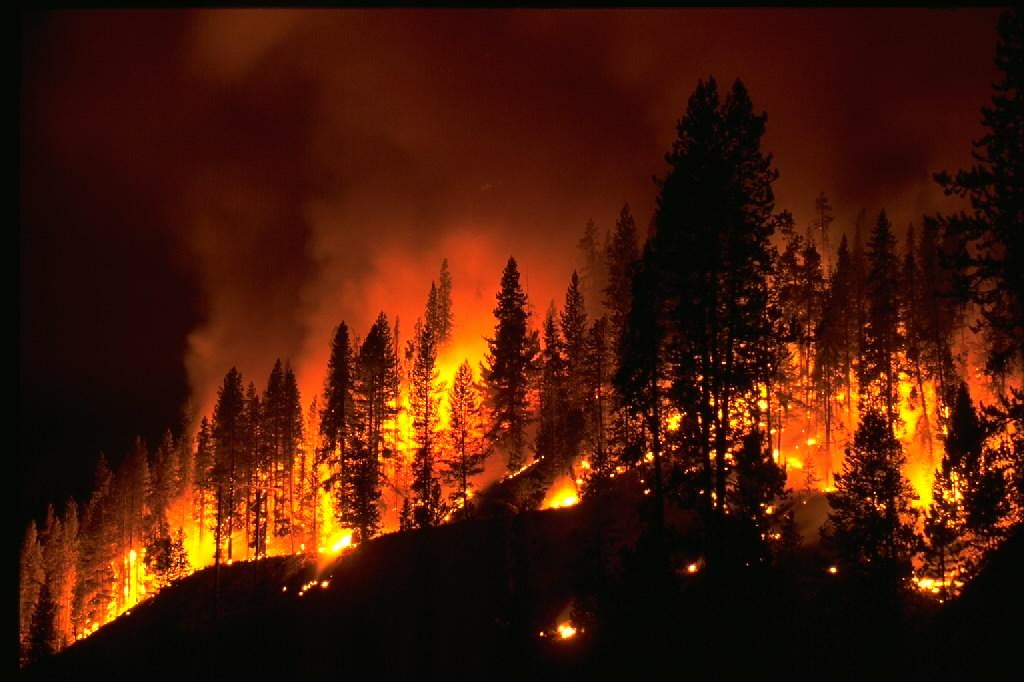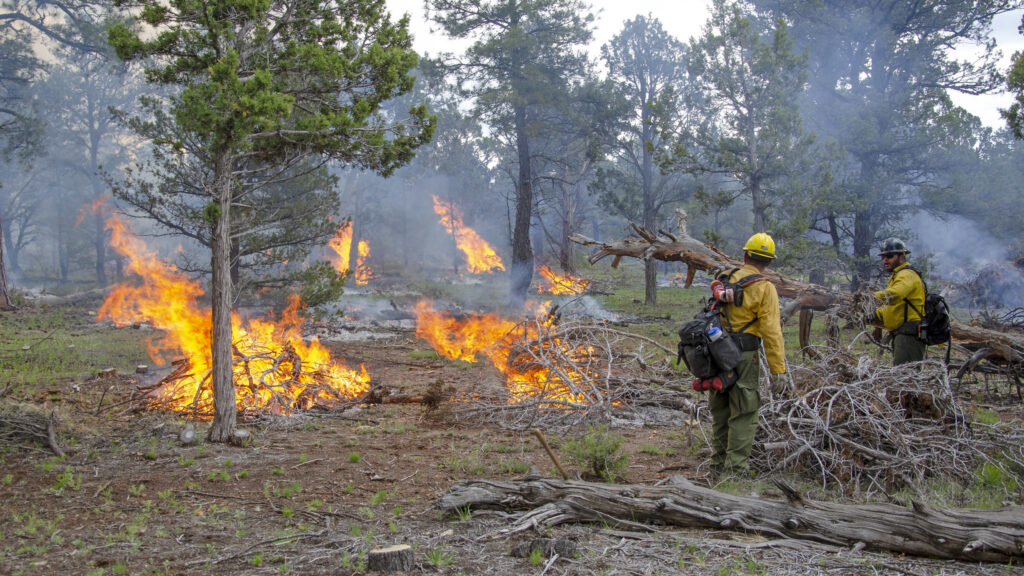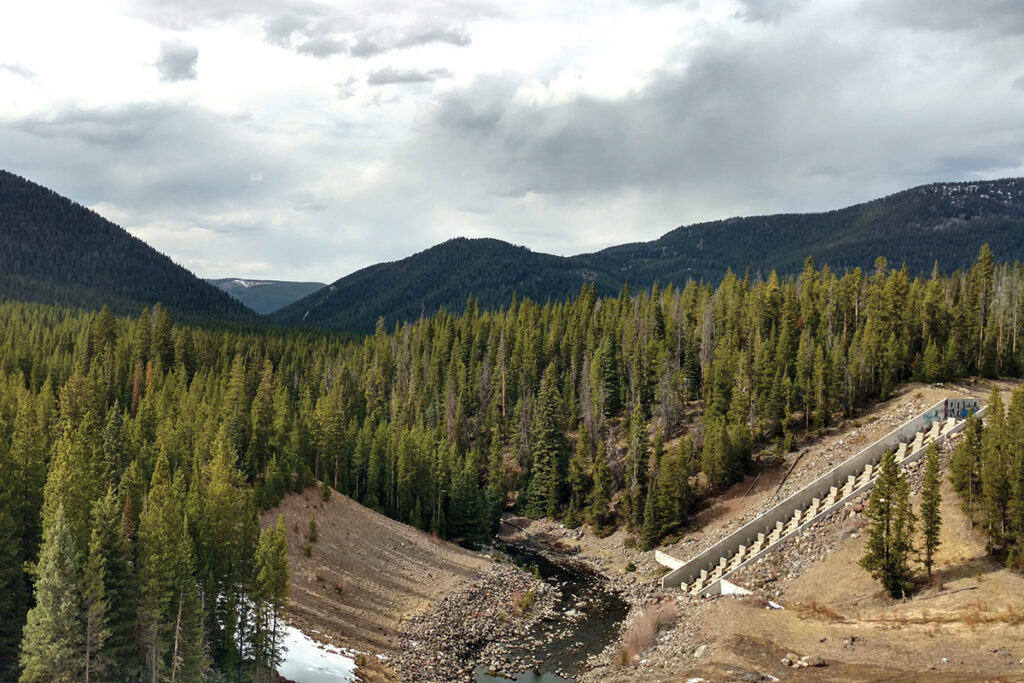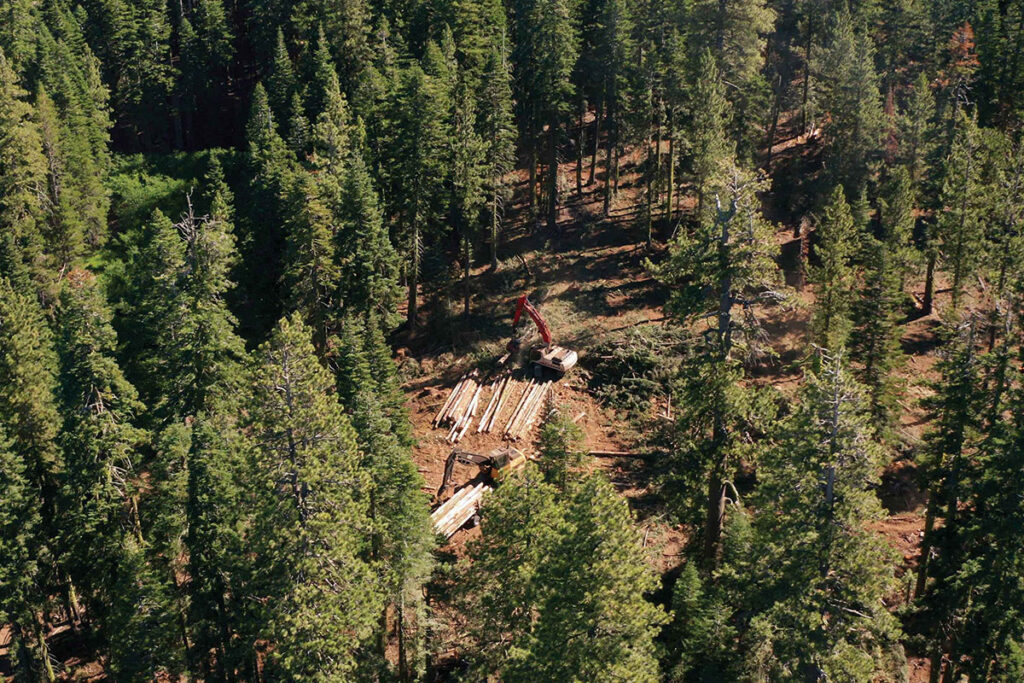This article was originally published in Environmental Law Forum, a publication of the Environmental Law Institute.
As the Caldor Fire made its menacing march toward South Lake Tahoe last summer, it burned through more than two hundred thousand acres and destroyed more than seven hundred homes. While the effects of the fire were tragic, a greater disaster was fortunately averted when firefighters steered the fire away from the city and to an area where fuel loads had been reduced through active forest management. This tamed the fire enough to get it under control.
South Lake Tahoe was not the only area where recent management actions helped stave off disaster in 2021. The Dixie Fire, the largest single fire in California’s history, burned nearly one million acres, including 70 percent of Lassen Volcanic National Park. Thankfully, firefighters “successfully leveraged the park’s previous and current fire and fuels management projects to preserve park resources and structures,” according to a Park Service release. Without the benefit of these projects, more of the park’s infrastructure could have been lost, making its recovery from the fire more difficult.
Fire is nothing new to western forests, which are adapted to flame due to climate, terrain, and Indigenous tribes’ use of prescribed fire for millennia. However, recent catastrophic wildfires are far more destructive than historic fire regimes. They are more likely to threaten old-growth trees, wipe out habitat for wildlife, and cause erosion that degrades watersheds and fish habitat.
And due to growing populations near forests, modern fires also threaten communities and property in ways not seen before. From 2005 to 2020, wildfires destroyed nearly 100,000 structures. But 62 percent of this destruction occurred in 2017, 2018, and 2020 alone, according to a report from Headwater Economics.
As with any complex phenomenon, no single cause explains the wildfire crisis. Climate change plays a major role by extending the wildfire season and drying out fuel. But decades of mismanagement also bear a significant part of the blame. The federal government’s fire suppression efforts throughout much of the 20th century removed low-intensity fire from forests. Unrestrained by burning, brush and small-diameter trees grew to compete with old growth, making forests more vulnerable to insects and disease. Eventually, the buildup of excess fuel encouraged fires to burn hotter and to move from the ground to the canopy, where they do more damage and are more difficult to suppress.
Unlike other factors contributing to the wildfire crisis, excess fuels are a problem the Forest Service can do something about in the short term. But it isn’t—or at least not enough.
Forest restoration, the use of mechanical thinning, prescribed fire, replanting, and erosion control techniques, could reduce wildfire damage while promoting healthier forests. However, the Forest Service reports an 80-million-acre backlog in needed restoration, more than 40 percent of the 193 million acres under the agency’s control. 63 million of these acres are deemed by the agency to be at high or very high risk of burning. Add to this the 54 million acres managed by the Department of the Interior, and the total area of federal land facing high or very high fire risks is larger than the state of California.
Yet, from 2009 to 2018, the Forest Service averaged only 4 million acres of forest restoration per year. At that rate, it would take decades to address the backlog even if, miraculously, no new risks arose in the interim.
Of course, wildfires are not limited to federal forests. But they nonetheless play an outsized role, due to the concentration of federal land in the west as well as the conditions throughout many national forests. While the federal government owns less than a third of forests nationwide, it controls roughly half the forested land in Arizona and Washington, 60 percent in California, Colorado, Montana, and Oregon, and 80 percent in Idaho and Nevada. Due to this concentration and differences in how federal and private lands are managed, the total area of federal land facing high or very high wildfire risks far exceeds the 52 million private acres facing such risks. And federal lands are consistently overrepresented in the total area burned, including 75 percent of the acreage burned in the West during 2020.
Recognizing the clear shortfall in managing federal forests, Congress appropriated roughly $1.5 billion in the recent infrastructure legislation for mechanical thinning, prescribed fire, and post-fire recovery projects. But there may be a long road from appropriating money to on-the-ground restoration because the problem is not simply a lack of funds. In a recent report, “Fix America’s Forests: Reforms to Restore National Forests and Tackle the Wildfire Crisis,” the Property and Environment Research Center documents significant obstacles keeping the Forest Service from clearing the restoration backlog.
For one, the agency’s personnel have shifted dramatically away from forest management. Perhaps understandably, the Forest Service has responded to fire’s political salience by shifting resources to suppression. The programs that fell victim to the agency’s “fire borrowing,” a euphemism for raiding other programs to fund firefighting efforts, were “often those that improve the health and resilience of our forested landscapes and mitigate the potential for wildland fire in future years,” according to a 2015 Forest Service report. Consequently, the number of staff specializing in forest management has declined by half since 1992, while the firefighting staff has doubled. “It is readily apparent that the Forest Service cannot meet national direction to increase the pace and scale of forest restoration with its current workforce,” concludes a 2019 survey of Forest Service managers.
Second, forest restoration projects must navigate significant bureaucratic obstacles, including review under the National Environmental Policy Act. Depending on the extent of anticipated impacts, NEPA may require the Forest Service to analyze a project through, in order of increasing complexity and expense, a categorical exclusion, environmental assessment, or environmental impact statement. The agency may also need to develop a range of alternatives to the project and analyze their impacts. The resulting documents routinely span hundreds of pages of dense text, with appendixes spanning another thousand pages or more.
While well-intentioned, NEPA reviews can significantly increase project costs and inject substantial delays. The average delay varies by type of review, from nine months to document a project’s consistency with a categorical exclusion to nearly three years for an environmental impact statement.
Unfortunately, NEPA presents a bigger obstacle for forest restoration projects than other Forest Service projects. Forest restoration projects are roughly twice as likely to require an environmental impact statement than the agency’s overall average. Forest restoration project reviews also tend to take longer, for a given level of analysis, than other project types. An environmental assessment for a forest restoration project takes, for instance, one and half times as long to complete as an environmental assessment for a mining plan of operations.
Moreover, the kind of ambitious, large-scale forest restoration projects needed to tackle the restoration backlog are likely to result in unusually complicated reviews and long delays. The top quintile of environmental impact statements, which take an average of six years to complete, may be a better approximation of the challenge.
NEPA is premised on a type of precautionary principle: that it is better to do nothing than to do something without fully studying the environmental and other risks. Whatever the case for this approach in other circumstances, the wildfire crisis is increasingly showing that the “do nothing” option presents its own substantial risks. A delay may increase the risk that a fire will break out, threatening communities, wildlife habitat, and watersheds. Or the cost and time required to review a project may sap the agency’s ability to pursue other restoration projects.
The recent infrastructure legislation includes a small but important tweak to address NEPA’s effect on forest restoration. An amendment proposed by Senator Steven Daines, Republican of Montana, and included in the final text authorizes the secretary of agriculture to declare an emergency situation based on hazards to human health and safety or threats to natural resources. If an emergency is declared, the Forest Service need only compare its proposed response and a “no action” alternative. This may facilitate more prompt responses by avoiding the need to develop and consider a range of alternatives where the costs of delay are especially high.
In many western forests, the Endangered Species Act presents an additional complexity. If a project funded or implemented by a federal agency may jeopardize a species or adversely modify critical habitat, the agency must consult with the Fish and Wildlife Service to identify ways that impacts to the species can be avoided or mitigated.
Again, the law’s intention is good but the means of pursuing it presents under-appreciated risks. Consider the Forest Service’s ill-fated Pumice Project, which was proposed in 2011 to reduce wildfire risks on nearly 10,000 acres of Klamath National Forest. The project faced a decade of objections from local environmental organizations over alleged impacts to the northern spotted owl, a species listed as threatened under the ESA. Ultimately, 2021’s Antelope Fire “burned through the site before a single chainsaw touched a tree, destroying the owl habitat that the environmental groups were trying to save,” report the Sacramento Bee’s Ryan Sabelow and Dale Kasler. Lamenting the time and resources sunk “into kind of bulletproofing” the environmental analyses, Drew Stroberg, a district ranger in the Klamath Forest, observed that “now, they might as well be in the trash can.”
In much of the West, delays can give the ESA a cascading effect. If a new species is listed or critical habitat is designated during the period between an environmental review and project completion, the agency can be penalized for failing to anticipate and hit a moving target. Under the Ninth Circuit’s 2015 Cottonwood decision, such regulatory changes require the Forest Service to restart consultation with the Fish and Wildlife Service at the forest plan level, then to restart consultation for individual projects, all before proceeding. The Obama administration urged the Supreme Court to reverse Cottonwood, explaining in a petition that the Court review the case that the ruling “has the potential to cripple the Forest Service.”
Litigation is another obstacle—one that compounds the others. Roughly two-thirds of the lawsuits challenging Forest Service projects from 2005 to 2019 targeted forest restoration projects. However, the consequences of litigation have not been evenly felt. 85 percent of cases were filed in courts within the Ninth Circuit. Nearly half were filed in only two district courts: the District of Montana and the Eastern District of California, both areas facing significant wildfire risks.
The effects of litigation are not limited to those projects that end up in court. The Forest Service is risk averse, preferring the delay and increased expense of ever-longer reviews over the negative media and political attention that comes with losing a lawsuit. Thus agency personnel respond to the perceived threat of litigation by trying to “litigation proof” NEPA and ESA reviews, which adds to the time and resources required while often failing to avoid lawsuits.
Conflict over the Bozeman Municipal Watershed Project presents a worst-case scenario of bureaucracy and litigation compounding the effects of each other. In 2004, the Forest Service determined that wildfire risks in an area of the Custer–Gallatin Forest threatened 80 percent of the city of Bozeman, Montana’s drinking water supply and required urgent action.
The Forest Service spent three years preparing a draft NEPA document. While the agency was working to finalize that document, a federal court overturned the delisting of the local grizzly bear population, triggering the agency’s duty to consult with the Fish and Wildlife Service. In 2010, the Forest Service released its NEPA and ESA analysis and approved the project. Administrative challenges were filed. While those were pending, the Ninth Circuit decided several unrelated cases that caused the agency to revise its analysis again to address perceived litigation risks.
After that additional review was complete, a lawsuit was filed. While that was pending, critical habitat was designated for the Canada lynx, which led the Ninth Circuit to hold in Cottonwood that projects like Bozeman’s required an additional round of analysis, and resulted in a district court enjoining the project. After the Forest Service completed the required analysis, the district court lifted its injunction in 2020, allowing the project to finally move forward.
Such delays could perhaps be justified if they resulted in material improvements to a seriously flawed project. But that wasn’t the case with the watershed project, which remains the same as it was originally proposed more than 15 years ago. It’s questionable what, if any, benefit the public got from the protracted litigation and bureaucratic morass.
Here, too, the recent infrastructure bill contains a small but potentially significant change. Senator Daines’s amendment provides that courts can only enjoin forest restoration projects in cases where the secretary of agriculture has declared an emergency situation if the court determines that the challenge is likely to succeed. This reform eliminates, at least for this class of cases, a Ninth Circuit rule that allows a plaintiff to obtain an injunction by raising only a “serious question” on the merits of its case.
Despite reforms in the infrastructure law, most of these obstacles remain and will delay implementation, increase costs, and encourage continued conflict over forest restoration. And even were it possible for the entire $1.5 billion to go to on-the-ground forest restoration, this would be less than $20 per acre in the backlog. Thus, it will be essential that the Forest Service work with outside partners to stretch the money further. States, tribes, and private parties are motivated to help due to the significant benefits healthy forests provide, including clean air and water, wildlife habitat, and recreation opportunities.
For instance, the National Forest Foundation and Salt River Project, a water utility, have formed the Northern Arizona Forest Fund to perform restoration in five national forests. Since 2015, the fund has raised more than $6.2 million from a diverse group of supporters, including the Arizona Department of Fish and Wildlife, the cities of Scottsdale and Phoenix, Coca-Cola, businesses dependent on outdoor recreation, and conservation groups. From the perspective of these supporters, paying for forest restoration today is much better than suffering the consequences of wildfire tomorrow. Thanks to these contributions, as well as volunteer time and expertise, the Northern Arizona Forest Fund has implemented fuel reduction projects on 13,600 acres, improved 2,600 acres of wetlands, planted 90,000 trees, and reduced erosion along 170 miles of roads and trails.
In many communities, raising such sums up-front for the promise of future benefits may be difficult. However, a recent financial innovation can overcome this challenge. Two nonprofit organizations, Blue Forest and the World Resources Institute, have pioneered the concept of a forest resilience bond, which raises private capital to pay for forest restoration and allows beneficiaries to pay investors back over time as benefits are achieved.
In 2018, the groups raised $4 million from investors to implement the first forest resilience bond in the Tahoe National Forest, with the State of California and the Yuba Water Agency signing on to repay the bond. Ironically, the Forest Service could not sign on as a beneficiary, despite arguably getting the biggest benefit, because it is forbidden from committing funds for terms longer than its current appropriation. Working with experts from the National Forest Foundation, the bond has enabled restoration projects covering 7,000 acres, completing in 4 years work that the Forest Service expected to take 10 to 12.
With this proof of concept, Blue Forest is scaling up this innovation substantially. It is currently raising $25 million for a second bond, to restore more than 28,000 acres of Tahoe National Forest. And it has three more bonds in the pipeline, which could help restore tens of thousands more acres across the West.
The Forest Service believes that these private models could be replicated in other areas where healthy forests provide substantial benefits. The agency’s National Partnership Office has developed a “Conservation Finance Opportunities Map” that seeks to match forest areas in need of restoration with local interests that would benefit from this work.
The Forest Service has also experimented with using private partners to reduce bureaucratic delays. In 2013, the Colville National Forest approved the “A to Z” project, a timber harvesting contract under which the winning bidder would take on the NEPA process in addition to performing the timber harvest and restoration work. Vaagen Brothers Lumber, the sawmill that won the contract, hired a third party to perform the environmental review under the Forest Service’s supervision (to prevent any appearance of a conflict of interest). Although a lawsuit was filed, a federal court upheld the arrangement.
Other agencies hampered by slow, expensive bureaucracies have found success with this approach. The Food and Drug Administration, for instance, struggled for decades to increase the pace of new drug reviews. In 1992, it struck a deal with pharmaceutical companies to pay higher fees in exchange for faster reviews. Within five years, the median approval time dropped from 27 months to 14 months. Today, industry is a strong advocate for the reform, supporting several reauthorizations despite increases in the fee. The same could be true in the forest context.
Partnering with local governments also presents an opportunity to stretch dollars further while obtaining the benefits of local knowledge and enthusiasm. Under the Forest Service’s Good Neighbor program, states, tribes, and counties can take the lead on planning and implementing timber sales and stewardship contracts. In 2020, Good Neighbor Authority projects constituted 11 percent of all timber sales in Forest Service Region 1, which covers Montana, North Dakota, and parts of Idaho and South Dakota. The program lets states keep receipts from timber contracts to fund additional restoration projects. But tribes and counties are arbitrarily excluded from this part of the program.
If the backlog is going to be overcome, reforms to address the obstacles described above are needed to scale up these innovative public-private partnerships. Such reforms should seek to encourage collaboration, rather than conflict, to increase the Forest Service’s flexibility to partner with states, tribes, and private parties, and to facilitate market reforms that can make forest restoration cheaper, or even profitable.
Some of these reforms are politically easier than others. For instance, there’s no good reason for the Good Neighbor Authority program to relegate tribes and counties to junior partner status. They should enjoy the same benefits as states do. Likewise, giving the Forest Service greater financial flexibility to form long-term partnerships is critical since forest restoration is not a one-time event but an ongoing responsibility.
Other reforms are likely to be harder. Ultimately, the time and expense required to navigate projects through environmental reviews and the courts needs to be reduced. Such delays may be frustrating to Forest Service officials. But it is a deal breaker for private investment in forest restoration. Consider the perspective of a potential investor in a forest resilience bond. Before locking up any substantial amount of funds, she would reasonably want to know how much a project will cost, when on-the-ground restoration will occur, and when she will see a return on her investment. The risk that the money will be committed only for a lawsuit to delay implementation indefinitely may be too great for many investors to bear.
Congress is considering many bills that aim to address different parts of these problems. Senator Wyden of Oregon, for instance, has introduced the National Prescribed Fire Act, which seeks to reduce Clean Air Act barriers to prescribed fire and to establish a categorical exclusion to reduce NEPA burdens. Senators Daines and Feinstein have introduced the Root and Stem Project Authorization Act, which seeks to make it easier to replicate the “A to Z” model and to reduce litigation risks by shortening the statute of limitations for challenges to forest restoration projects. And Congressman Westerman of Arkansas, the only forester currently serving in Congress, has introduced the comprehensive Resilient Federal Forests Act, which among many other things seeks to streamline the NEPA process by expanding categorical exclusions and to legislatively reverse the Ninth Circuit’s Cottonwood decision.
Reforms like these could be the difference between tackling the forest restoration backlog or allowing the wildfire crisis to continue worsening. With fire seasons growing longer, millions of acres burning every year, and more people and homes at risk, the stakes could not be greater.







